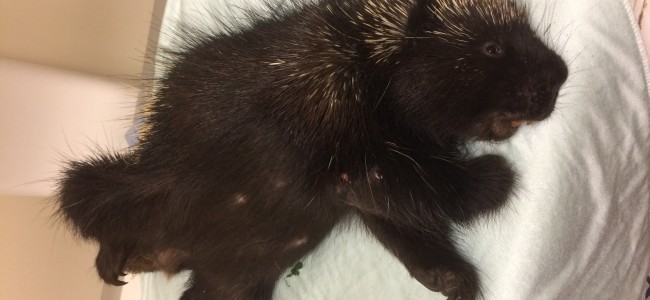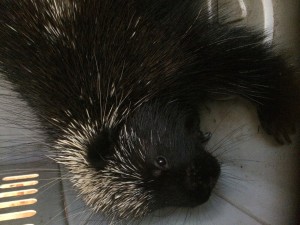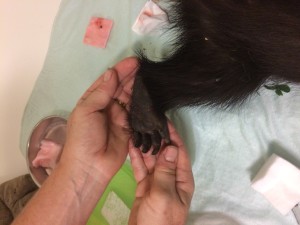Although I really do small animals and rodents and rabbits, I occasionally have been known to show my hand with anything mammalian. This includes some wildlife work- squirrels, raccoons, an occasional deer- where I have been asked to help out. Recently I have had the pleasure of working with Guylaine, who has received all of the papers necessary to deal with wildlife. It is great when we have a client with a baby raccoon whose mother has been killed, to be able to refer the people to her. I help her in whatever manner that I can- medications, x-rays and sedation as needed. She does the work, I get to play!
Most recently I received a call from her concerning a porcupine. He was walking along the road near her country home, and was obviously lame. This was unusual behavior, so she managed to get him in a crate (I am still not sure how) and called me.
“How do you feel about looking at a porcupine?” she asked. Having only really dealt with the nasty quills in many of my canine patients who get a little too close, I replied “If you can handle him, I will help!” to which she replied “I don’t think he will be afraid of needles!”
I have worked with hedgehogs occasionally, who also have defensive spines. One trick that I have learned is to place them in water so that they unfurl, and you can then handle them from underneath. However, they do not lose their quills like our North American porcupines, who can release the quills interspersed in their fur when under attack.
This porcupine was a robust older gentleman, weighing in at 20 pounds. When we looked at him in the crate, with the spines all erect, I realized there was no way we were going to get him in a bath! After some deliberation, we fashioned a syringe containing some anesthetic on a pole, using tape to hold the syringe in place. I had the plunger held with another rod and we were ready. Guylaine pushed the patient into the back of the crate, who had now emitted anal glands in defense, as well as chattering his teeth in anger. Not knowing exactly what area I was injecting, I managed to slip the syringe needle into the bristling quills, and hit some tissue. We injected. Then we waited.
Porcupines are slow moving rodents, completely herbivorous. Their only real predator is the fisher, who gets them to raise up and then attack their underbelly. Their main fault is that they eat the bark of trees, which is often fatal to trees.
Fortunately, our patient succumbed to my sedation, and soon enough, we were able to remove him from the crate for a closer look. What a privilege it is to see one of these creatures close up! Their spines when brushed in the right direction are not dangerous, and underneath is a lovely fur. Their feet pronate inwards, aiding for climbing. Their hands are wrinkly, reminding me of a raccoons, with large nails. Their teeth- well, typical rodents, they are huge, very much like beaver I have had chance to meet. He was a definite male, and he was also covered in ticks.
However, this was not to be a case of animal comparative anatomy, and we soon saw that his right front leg was badly injured, with infected bite wounds. Radiographs reveal a severe osteomyelitis (bone infection) causing a fusion of his elbow. He would never climb properly again.
This is where wildlife rehabilitation is tough- we could not let this old man back out- he would die a slow and horrible death. So unless a permanent home could be found, it would be kinder to euthanize him. Fortunately for him the Eco museum in Ste. Anne de Bellevue had space for another porcupine. Arrangements were made, antibiotics and pain killers were administered, and off he went. So if you have never visited the Eco museum, please go and say hello to my spiny friend. It is a wonderful center for education about wildlife and fauna, and by paying their small admission fee, you are helping them be able to accept the occasional permanently damaged animal.



